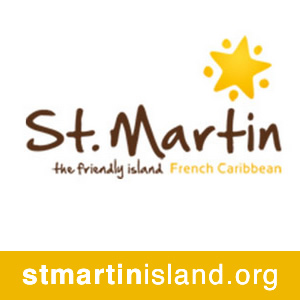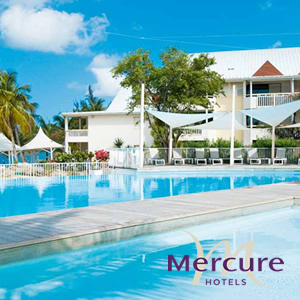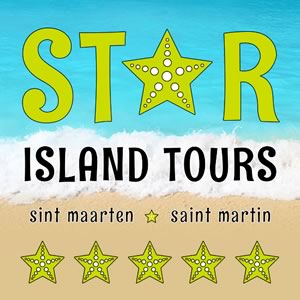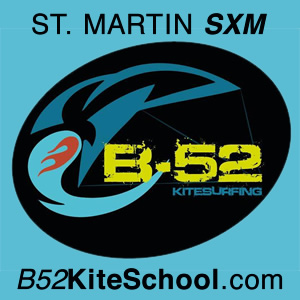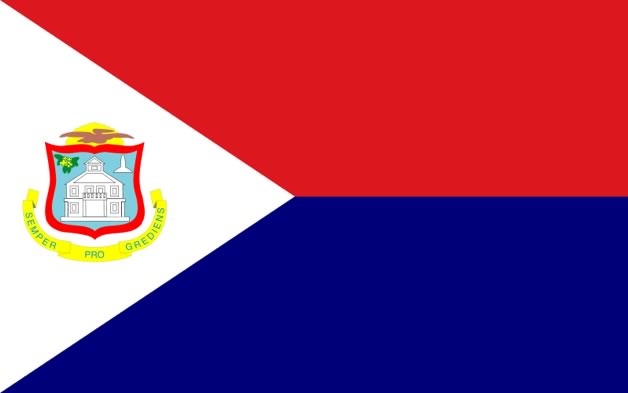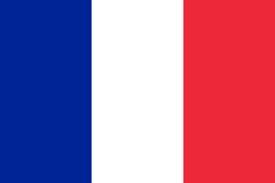Saint Martin, the French side, is a Overseas Collectivity of France.
Sint Maarten, the Dutch side, is a constituent country of the Kingdom of the Netherlands.
This unique two nation island is located south of Dominica and north of St. Lucia, is part of the Leeward Islands in the Eastern Caribbean Sea. View Map. St. Martin or Sint Maarten is famous for being harmoniously shared by the Dutch and French. Very popular with cruise ships and vacationers that come for relaxing, sun bathing, shopping, dining, sailing and other water sports.
1. Dual Nationality:
St. Maarten/St. Martin is the smallest island in the world to be shared by two nations. The southern half, St. Maarten, is a constituent country of the Kingdom of the Netherlands, while the northern half, St. Martin, is an overseas collectivity of France.
2. Borderless Island:
Despite being divided into two territories, the border between the Dutch and French sides of the island is completely open. Visitors can freely move between the two sides without any border checks, making it a seamless experience.
3. Cuisine:
The island is renowned for its diverse culinary scene, influenced by both Dutch and French cultures as well as the Caribbean. Local specialties include Johnny cakes (a fried bread), saltfish, conch, and various seafood dishes. The French side is particularly known for its gourmet dining options.
4. Airport Experience:
Princess Juliana International Airport on the Dutch side of the island is famous for its proximity to Maho Beach. Planes landing at the airport pass very close over the beach, creating a thrilling experience for sunbathers and plane enthusiasts alike.
5. Cultural Diversity:
The island's population is incredibly diverse, with a mix of Afro-Caribbean, European, and other cultures. This diversity is reflected in the island's festivals, music (such as calypso and reggae), and arts scene, making it a rich cultural melting pot in the Caribbean.
Kitesurfing of course! B52 kitesurfing center SXM is located on the Nettle Bay Lagoon in Saint Martin. They offer kitesurfing and foiling lessons and rentals.
To get around the island, car rental is very affordable, see the rates for yourself at SAX Car Rental. Their secret is great rates and superior customer service.
Enjoy your stay!

"O Sweet Saint Martin’s Land"
Euro - French side.
One can also get by with US Dollar
Overseas collectivity of France - French side.
Dutch side: Philipsburg
"While your brother's beard is burning, soak yours."
"You never miss the water 'till the well run dry."
"When town is asleep, thief is on the prowl."
"Don't be like the cow that gave a good pail of milk, and then kicked it over."
"When rum in, wits out."
- Shopping in Front Street, Philipsburg - from duty-free jewelry to up-market clothing and souvenirs, this is a must-see part on the beach in the Dutch side.
- Hiking at Pic du Paradis - Take a drive or taxi up Pic du Paradis (Paradise Peak) Mountain's 1,492 feet for a breathtaking view of St. Martin/St. Maarten, Anguilla, Saba and St. Eustatius. It is suggested you visit as part of a large group rather than on your own. There is a narrow, undeveloped road near the top of the peak, but the bundu-bash is worth the while. Pic du Paradis is located between the towns of Grand Case and Marigot at the centre of the island.
- Loterie Farm for Hiking, Biking, Ziplining - Nature and extreme sport lovers can hike, climb or zipline through the Loterie forest or bike on the 150 acres of forest and farmland located near the foot of Pic du Paradis. This is for the adventurous traveler who is not scared of a bit of bumping and nicks up and down hills. End your visit with lunch or dinner in the well-reviewed Hidden Forest Café, or enjoy their signature drink in the Tree Lounge, called 'Sex in the Tree'. www.loteriefarm.com
- Play Some Tables at Casino Royale - This glitzy casino, see playmaho.com, is located across the street from the Sonesta Maho Beach Resort and has 400 slot machines and 20 gaming tables featuring roulette, craps, baccarat, blackjack and poker. Showroom Royale Theater, an 800-seater, also entertains guests nightly with their 10pm shows. (playmaho.com)
- See Airplanes at Maho Beach - This sandy stretch of 100 feet wide is more famous for its airplanes than its soft sands and palm trees. It is in very close proximity to the Princess Juliana International Airport of St. Martin/Maarten. Many beach goers and thrill seekers visit this spot as very big airplanes (like Boeing 747's or Airbus A340) fly over their heads, seconds away from landing. This is a popular beach with one or two shops and bars plus nice clear water to swim in.
- Great Bay Beach - This beach is closest to the cruise terminal, within walking distance or accessable via water taxi. Everything you want from restaurants, souvenirs, upmarket clothing, jewellery, guest houses, hotels and more to be found here. The beach stretches parralel to Front Street, so it can take a while to see everything and get your watersports and swimming in.
- Orient Beach - A stunning setting on the French side of the island. Something to take note of here, is that it is divided into three sections: a nude beach, topless beach and bikini/normal beach. If you have kids, this is to be noted as some patrons walk around nude all over Orient Beach. Lots of watersports, from jetskiing to parasailing and restaurants on the beach offer great cocktails. The ocean is wilder here than at some Dutch side beaches, but the sand is white and the water clear.
- Simpson Bay - This beach area is fun to visit as it is close to many night clubs, piano bars, casinos and restaurants. It's the 'happening' area in St. Maarten when it comes to nightlife. Also close to various resorts on the beach, like the Simpson Bay Resort (www.simpsonbayresort.com), it is centrally located in a bay on the Dutch side, between the two capitals Marigot and Philipsburg, and is not far from the airport. Not to be missed for close proximity to a fun night out.
- Divi Little Bay - This scenic bay has various resorts, like the Little Bay Resort (www.dividlittlebay.com) that is close to Philipsburg, the Dutch capital, in fact it is about an hour's walk - up the hill - from the cruise ship dock. Here are various water sport activities to participate in in, calm, crystal clear waters; even a small grocer, coffee shop, restaurants, day spa and shops to enjoy. Definitely one of the best beach areas in St. Maarten.
- Cupecoy Beach - This is actually a set of three beaches, famous for their breathtaking views of limestone cliffs at sunset. Located on the island's southwest tip, Cupecoy is surrounded by limestone cliffs. Enjoy lovely views of Saba in the distance from one of the area's beach bars, or by buying a cold beer from one of the local vendors walking along the shore. Also note, the northwest part of Cupecoy Beach is a GLBT-friendly beach, and families should beware that clothing is sometimes optional here.
The island of St. Martin/Maarten lies towards the north of the Lesser Antilles, about 240km to the south east is the island of Guadeloupe. St. Martin/Maarten has the Atlantic on its eastern side and the Caribbean Sea on the west coast. The island's total surface area is 88km2, the island is 15km long and 13km wide at its longest and widest points. The island of St. Martin/Maarten, interestingly, is the closest part of France to US shores and a three-and-a-half-hour flight from New York, a 2,5 hour flight from Miami (Florida), a 45 minutes from the islands of Guadeloupe, Puerto Rico and 8 hours flight from Europe. Neighboring islands include Anguilla, St. Barts, Saba, Statia, Saint Kitts and Nevis.
The island of St. Martin/Maarten is also separated from the British territory by the Anguilla Channel. On it's south east its separated with Saint Barthélemy by the Saint-Barthélemy Channel. The highest hilltop is the Pic Paradis (424m) in the French side. There are many dry guts on the island, no rivers
Longitude : 63.5deg West / Latitude : 18.5deg North.
Average elevation above sea level: 20 meters.
Highest point: Pic du Paradis at 424 meters.
"According to legend, Columbus sighted and perhaps anchored at the island of Saint Martin on November 11, 1493, the feast day of Saint Martin of Tours. In his honor, Columbus named the island San Martin. This name was translated to Sint Maarten (Dutch), Saint-Martin (French) and "Saint Martin" in English. At Columbus's time, St. Martin was populated, if populated at all, by Carib Amerindians. The former Arawaks had been chased by the Caribs coming from the North coast of South America a short time before the arrival of the Spaniards who followed in Columbus' wake...
The Caribs' territory was not completely conquered until the mid-17th century when most of them perished in the struggle between the French, English, Dutch, Danes and Spanish for control of the West Indies. The Dutch first began to ply the island's ponds for salt in the 1620s. Despite the Dutch presence on the island, the Spaniards recaptured St. Martin in 1633 and, one year later, built a fort (now Ft. Amsterdam) and another artillery battery at Pointe Blanche to assert their claim and control access to Great Bay salt pond. The Spaniards introduced the first African slaves to the area in the 16th century but the main influx of African slaves took place in the 18th century with the development of Sugarcane plantations by the French Protestants and Dutch. Slavery was abolished in the first half of the 19th century, whereupon some of their territories the British imported Chinese and East Indians to take the place of slaves. Thus, St. Martin and the other islands are populated by a mixture of Amerindian, European, African, Indians and Asian peoples. West Indian cultures such as in St. Martin are, consequently, exceedingly rich and varied.” [Source: Wikipedia]
When in the US Virgin Islands - St. Croix, St. Thomas and St. John - drive on the left-hand side of the road.


